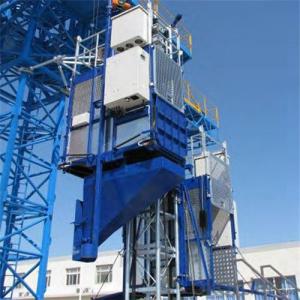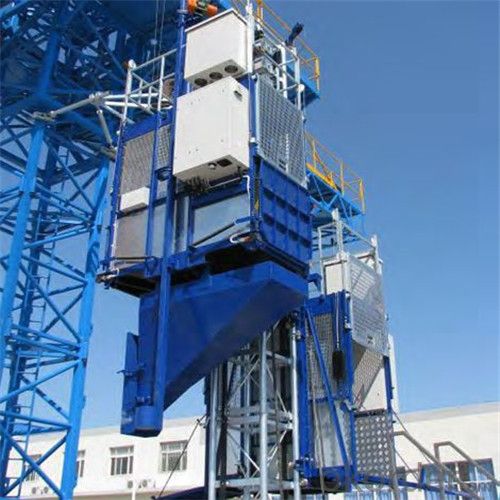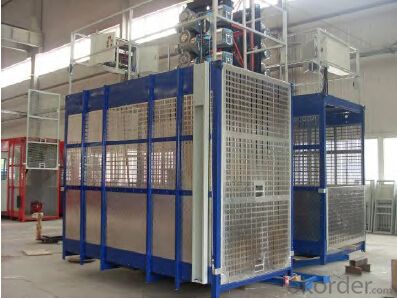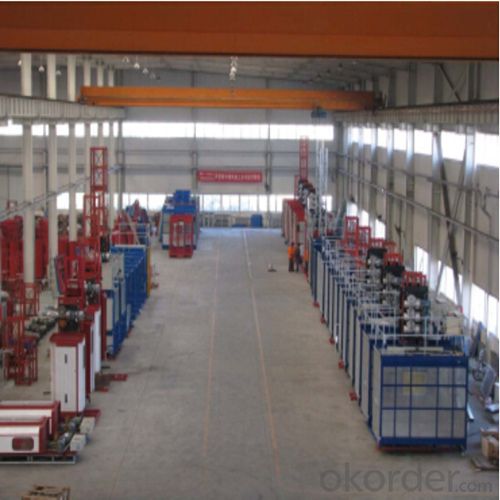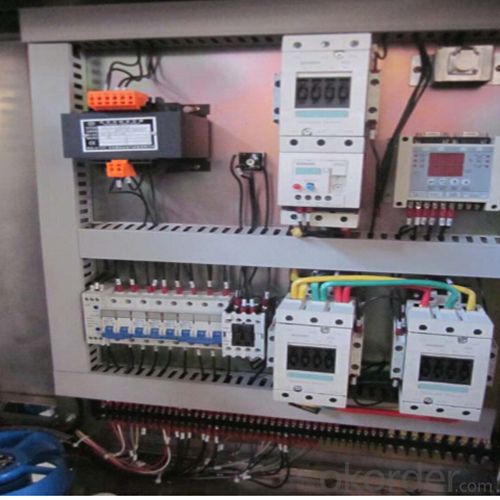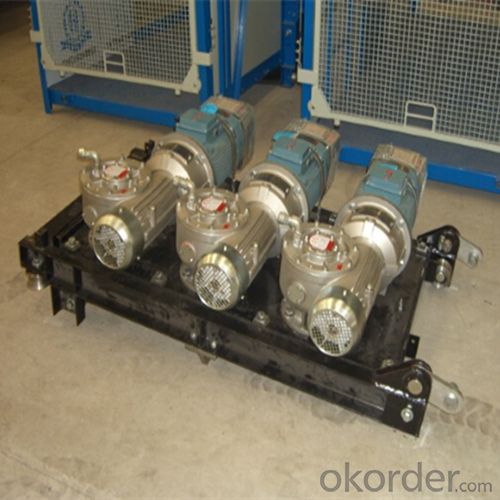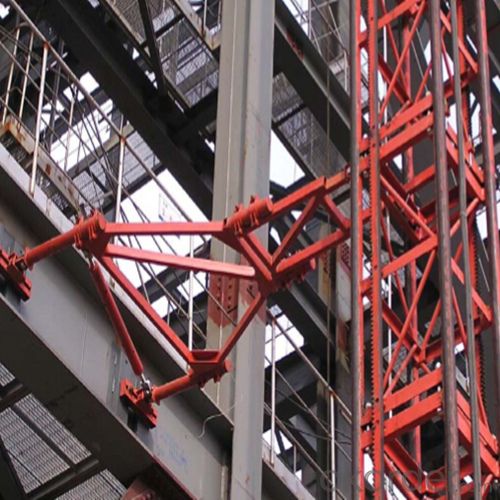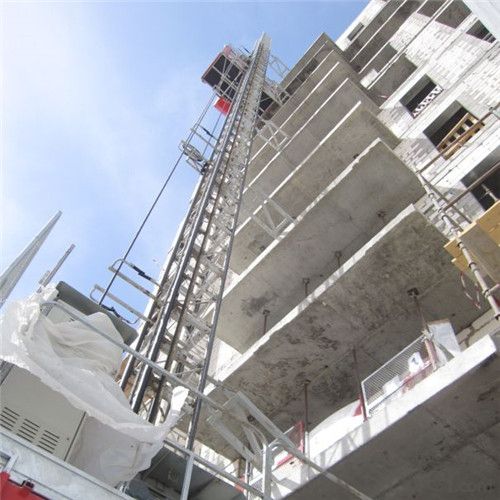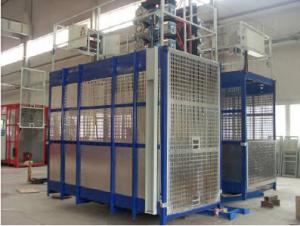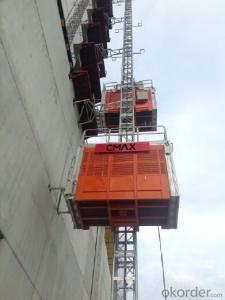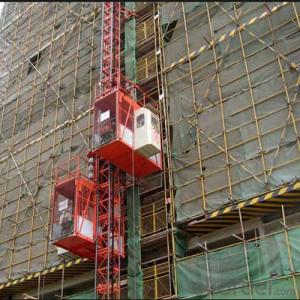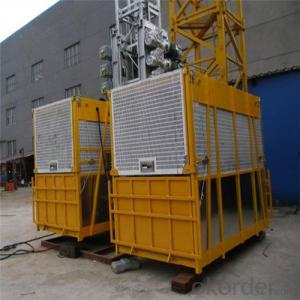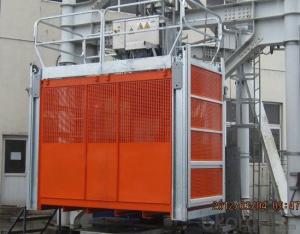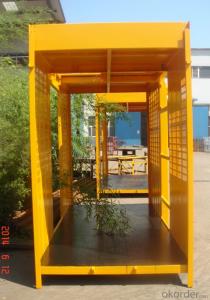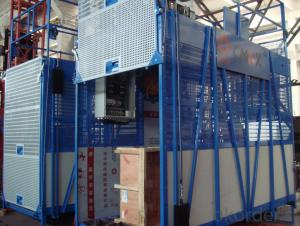Building Hoist SC100 with VF System, Current-restriction Function
- Loading Port:
- China main port
- Payment Terms:
- TT or LC
- Min Order Qty:
- 1 unit
- Supply Capability:
- 30 unit/month
OKorder Service Pledge
OKorder Financial Service
You Might Also Like
SC Hoist is a Rack and Pinion EL. Lift, used on construction site for transportation of personnel and materials. It is installed and dismounted conveniently and can grow as high as the buildings grow in height.
There are single cage and twin cage hoists. A single cage can be quickly transformed into twin cage hoist by adding a cage and other parts. The hoist payload can be increased by adding counterweight equipment.
SC Hoist has reliable electrical and mechanical safety device. It is a efficient and safety vertical transporting equipment.
Main Parts of Building Hoist
1. Adopts the most advanced VF speed control device and microcomputer programmable logic controller.
2. Stepless speed control helps eliminate the concussion during start up and braking, steady the operation process, and ensures automated leveling.
3. Adopts open loop V/Fcontrol; the speed control precision can reach ±2~3%. Realizes accurate low speed positioning of the hoist and avoid slipping during downward stopping of hoist.
4. The VF system has current-restriction function, ensuring a small current when motor start up and reducing the concussion to power supply. It reduces the engery consumption and mitigates effects to on site electric equipments.
5. The steadiness during running mitigates concussion to mechanical parts, reduces wears of rack, pinion and the brake and prolongs the spare parts'life.
6. The VF system also has the over voltage protection,low voltage protection, overcurrent, overload and anti-stalling protection functions,
7. The system applies the special software for hoists developed by our company, making the operation more safe and reliable.
Building Hoist images
CMAX Building Hoist
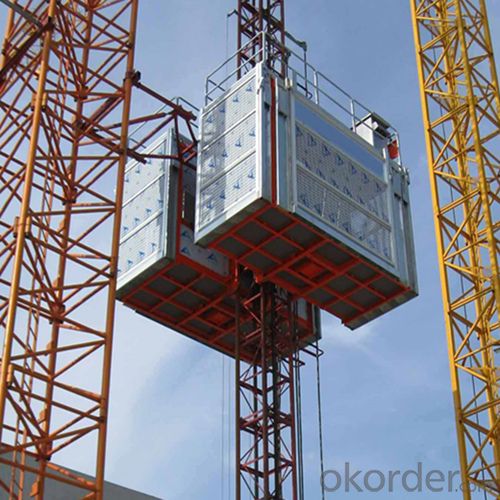
Anchorage System
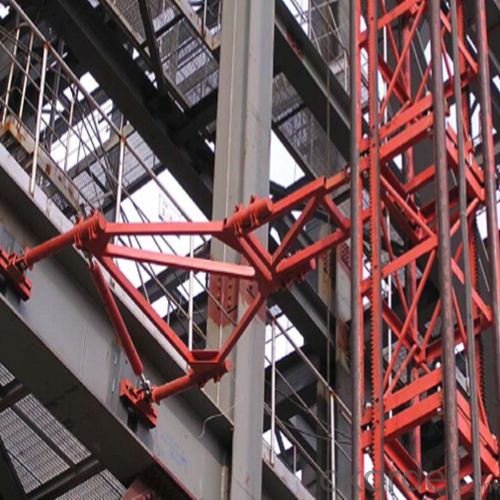
Driving Unit

Warehouse
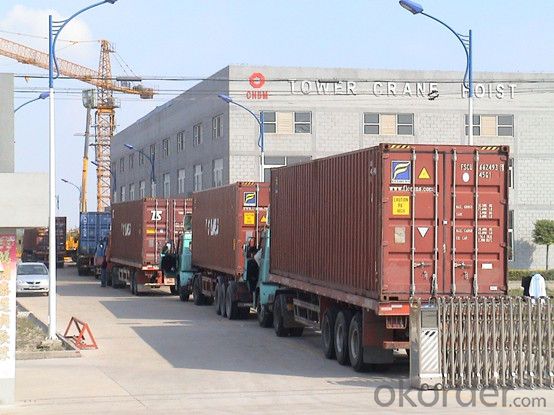
Building Hoist Specifiction
Main technical data | Unit | Value |
Rated load | kg | 1000 |
Rated erection load | kg | 1000 |
Jib attachment rated load | kg | 300 |
Cage size | m | 3.0×1.3×2.5 |
Maximum lifting height | m | 250 |
Lifting speed | m/min | 33 |
Rated output | kW | 2×11 |
Voltage rating | V | 380/440 |
Rated frequency | Hz | 50/60 |
Rated current | A | 2×23.5 |
Power supply fuses | A | 63 |
Protective class | / | IP55 |
Load duration factor | / | FC-25% |
Safety device | m/s | 1.2 |
Enclosure weight | kg | 980 |
Cage weight | kg | 1750 |
Counterweight | kg | / |
Mast section weight | kg | 125/145 |
Mast section length | mm | 1508 |
If you have special requirement on power, please state it when order the consignment.
We can produce the cage and lengthen the tie-in according to the size the customer requested.
We can heighten the erection height according to the customer’s request.
“/” means the item does not exist.
FAQ of Building Hoist
Q: What is the building hoist main purpose?
A: Building hoist equipped with double or single cabin to transport the materials and labors up and down. It's the ideal construction equipment for vertical transportation in the field of construction.
Q: What is the main structure of building hoist?
A: The P/M construction hoist mainly contains metal structure, driving system, electrical control system, cable guide & protection system, electrical top crane and safety device.
Q: What is the meaning of the building hoist’s code?
A: Take SC200/200 for example: “SC” stands for rack and pinion hoist, “200/200” stands for double cage and capacity is 2 tons per cage. “SC200” stands for single cage and capacity is 2 tons.
Q: What is the dimension of the cage?
A: Normally the cage dimension is 3X1.5X2.5M (L/W/H) for 2t type hoist. Details should be checked according to our quotation sheet. Also, the size can be customized according to the factual site condition. There are two doors (entrance & exit doors) for each cage, It can be produced as up & down sliding or ramping model for safety and convenience.
- Q: The user is inquiring about the possibility of purchasing a second-hand construction hoist.
- <p>Yes, you can buy a used building hoist. Many companies specialize in selling refurbished or used construction equipment, including building hoists. You can find them through online marketplaces, auction sites, or by contacting construction equipment dealers directly. It's important to inspect the hoist for any damages or wear and ensure it meets safety standards before purchase. Additionally, consider the hoist's age, maintenance history, and any warranties that might still be valid.</p>
- Q: Explain the distinctions between electric and manual building hoists, focusing on their operation, efficiency, and use cases.
- <p>Electric building hoists are powered by electricity and offer faster operation, greater efficiency, and the ability to lift heavier loads. They are ideal for large-scale construction projects where rapid movement of materials is necessary. In contrast, manual hoists are operated by hand and are typically smaller, more portable, and require human effort to lift materials. They are suitable for smaller projects or where power supply is limited. Electric hoists are more automated and can be controlled remotely, while manual hoists require constant physical effort and are less efficient in terms of speed and load capacity.</p>
- Q: Is it possible to utilize a building hoist for the purposes of renovation projects?
- <p>Yes, a building hoist can be used for renovation work. These hoists are designed to lift and lower materials and personnel efficiently, making them ideal for construction and renovation projects. They help in moving heavy materials such as bricks, cement, and tools to different floors without the need for manual labor, thus increasing safety and productivity. However, it's crucial to ensure that the hoist is properly installed, maintained, and operated by trained personnel to avoid accidents and ensure the safety of all involved.</p>
- Q: Is it possible to use a building hoist for lifting light objects without any additional tools?
- <p>Yes, a building hoist can be used for lifting light objects without using any tools. Building hoists are designed to lift a variety of materials, including lighter items, within their weight capacity. However, it's crucial to ensure that the hoist is rated for the weight of the object and that safety protocols are followed to prevent accidents. Always consult the hoist's manual for specific guidelines on weight limits and safe operation procedures.</p>
- Q: What is the capacity range of a building hoist in terms of lifting objects?
- <p>A building hoist can be used for lifting both large and small objects, depending on its design and capacity. These hoists are engineered to handle various weights, typically ranging from a few hundred pounds to several tons. The specific size and weight of the objects that can be lifted are determined by the hoist's lifting capacity, which is a crucial factor to consider when selecting a hoist for a particular job. It's important to ensure that the hoist's capacity exceeds the weight of the objects to be lifted for safety and efficiency.</p>
- Q: This question asks about the routine maintenance procedures for a building hoist, which is a piece of equipment used in construction to lift materials and personnel.
- <p>To maintain a building hoist, follow these steps: Regularly inspect the hoist for any signs of wear or damage, especially the cables, pulleys, and safety mechanisms. Lubricate moving parts as per the manufacturer's guidelines to reduce friction and prevent rust. Ensure all safety features, such as emergency stops and limit switches, are functioning correctly. Keep the hoist clean and free from debris, which can interfere with its operation. Check the electrical connections for any signs of corrosion or damage. Perform load tests to confirm the hoist's lifting capacity and ensure it meets safety standards. Always follow the manufacturer's maintenance schedule and guidelines, and have a professional service the hoist periodically.</p>
- Q: This question asks for methods to protect lifting equipment from damage while it is being transported or stored.
- <p>To prevent damage to lifting equipment during transportation or storage, follow these guidelines: 1. Use protective covers or wraps to shield equipment from environmental elements. 2. Securely fasten equipment to prevent movement during transit. 3. Store equipment in a dry, clean area to avoid rust and dirt accumulation. 4. Regularly inspect equipment for signs of wear or damage before and after use. 5. Follow the manufacturer's guidelines for weight limits and proper handling. 6. Use padding or cushioning materials to protect equipment from impacts. 7. Ensure that all parts are properly lubricated to prevent rust and facilitate smooth operation. By adhering to these practices, you can significantly reduce the risk of damage to lifting equipment.</p>
- Q: Is it possible to use a building hoist to lift various materials simultaneously?
- <p>Yes, a building hoist can be used for lifting multiple materials at once, provided the total weight does not exceed the hoist's load capacity. It's crucial to ensure that the materials are securely fastened and balanced to prevent tipping or damage. Always follow the manufacturer's guidelines and safety regulations to avoid accidents and ensure the safe operation of the hoist.</p>
- Q: Can a building hoist be utilized for lifting objects that exceed manual lifting capabilities?
- <p>Yes, building hoists are specifically designed to lift and transport objects that are too large or heavy for manual lifting. They are commonly used in construction to move materials and equipment to various levels of a building. Building hoists are equipped with safety features and can handle substantial weight, making them an essential tool in construction projects where heavy objects need to be moved efficiently and safely.</p>
- Q: This question asks about the time required to install a building hoist, a device used for lifting materials in construction.
- <p>The time it takes to install a building hoist can vary significantly based on factors such as the type and size of the hoist, the specific building requirements, and the experience of the installation team. On average, it can take anywhere from a few hours to a couple of days. For smaller hoists, installation might be completed within a day, while larger, more complex systems could take longer. It's important to note that safety checks and regulatory compliance verifications are also part of the process, which can add to the total installation time.</p>
Send your message to us
Building Hoist SC100 with VF System, Current-restriction Function
- Loading Port:
- China main port
- Payment Terms:
- TT or LC
- Min Order Qty:
- 1 unit
- Supply Capability:
- 30 unit/month
OKorder Service Pledge
OKorder Financial Service
Similar products
Hot products
Hot Searches
Related keywords
